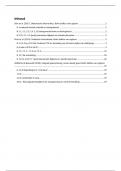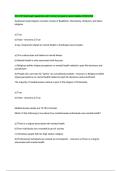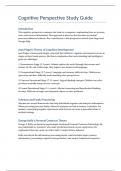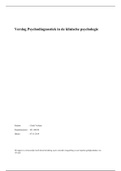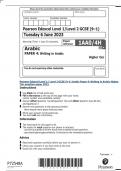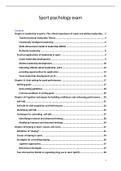Kay Segaar
Summary Industrial Organization
Inhoud
Chapter 1 – What is Industrial Organization?................................................................................. 3
Chapter 4 – Competition, Equilibrium, and Efficiency .................................................................... 3
4.1 Perfect competition....................................................................................................................... 3
4.2 Competitive Selection ................................................................................................................... 4
4.3 Monopolistic Competition............................................................................................................. 4
4.4 Efficiency ....................................................................................................................................... 5
Chapter 5 – Market Failure and Public Policy ................................................................................. 6
5.1 Externalities and Market Failure ................................................................................................... 6
5.2 Imperfect Information ................................................................................................................... 7
5.3 Monopoly ...................................................................................................................................... 7
5.4 Regulation...................................................................................................................................... 8
5.5 Competition Policy and Antitrust .................................................................................................. 8
5.6 Firm Regulation ............................................................................................................................. 9
Chapter 6 - price discrimination .................................................................................................. 10
6.1 Selection By Indicators ................................................................................................................ 11
6.2 Self Selection ............................................................................................................................... 11
6.3 Non-Linear Pricing ....................................................................................................................... 12
6.4 Auctions and Negotiations .......................................................................................................... 13
6.5 Is Price Discrimination Legal? Should It Be? ................................................................................ 13
Chapter 7 – Games and Strategies............................................................................................... 14
7.1 Nash Equilibrium ......................................................................................................................... 14
7.2 Sequential Games ........................................................................................................................ 15
7.3 Repeated Games ......................................................................................................................... 15
7.4 Information.................................................................................................................................. 16
Chapter 8 – Oligopoly ................................................................................................................. 17
8.1 The Bertrand Model .................................................................................................................... 17
8.2 The Cournot Model ..................................................................................................................... 18
8.3 Bertrand vs. Cournot ................................................................................................................... 19
8.4 The Models at Work: Comparative Statics .................................................................................. 19
Chapter 9 – Collusion and Price Wars .......................................................................................... 20
9.1 Stability of Collusive Agreements ................................................................................................ 20
9.2 Price Wars.................................................................................................................................... 21
9.3 Factors That Facilitate Collusion.................................................................................................. 21
1
,Kay Segaar
9.4 Empirical Analysis of Cartels and Collusion ................................................................................. 22
9.5 Public Policy ................................................................................................................................. 22
Chapter 10 – Market Structure.................................................................................................... 23
10.1 Entry Costs and Market Structure ............................................................................................. 23
10.2 Endogenous vs. Exogenous entry costs ..................................................................................... 25
10.3 Intensity of competition, Market Structure, and Market Power .............................................. 25
10.4 Entry and Welfare ..................................................................................................................... 26
10.5 Entry Regulation ........................................................................................................................ 27
Chapter 11 – Horizontal Mergers ................................................................................................ 28
11.1 Economic Effect of Horizontal Mergers .................................................................................... 28
11.2 Horizontal Merger Dynamics..................................................................................................... 29
11.3 Horizontal Merger policy ........................................................................................................... 29
Chapter 13 – Vertical Relations ................................................................................................... 31
13.1 Vertical Integration.................................................................................................................... 31
13.2 Vertical Restraints ..................................................................................................................... 33
13.3 Public Policy ............................................................................................................................... 34
Chapter 14 – Product Differentiation .......................................................................................... 35
14.1 Demand for Differentiated Products ......................................................................................... 35
14.2 Competition With Differentiated Products ............................................................................... 35
14.3 Advertising and Branding .......................................................................................................... 38
14.4 Consumer Behaviour and Firm Strategy ................................................................................... 39
14.5 Public Policy ............................................................................................................................... 39
2
,Kay Segaar
Chapter 1 – What is Industrial Organization?
- Market power can be defined as the ability to set prices above costs. Specifically to set prices
above marginal costs.
- Allocative efficiency is the point where the price of a good or service equals the marginal
cost of production. The price consumers are willing to pay at this point is equal to the
marginal utility they get. → the optimal distribution is achieved when marginal utility equals
marginal costs
- Firms with greater market power have less incentive to be cost efficient. Market power
implies: productive inefficiency → can be defined as the increase in cost that result from
market power
- Rent seeking is the spending of unproductive resources by firm in an attempt to influence
policymakers to keep market power → rent seeking is a result when market power is
maintained by government intervention
Chapter 4 – Competition, Equilibrium, and Efficiency
4.1 Perfect competition
Main features of a perfect competitive market are:
1. Atomistic firms: there are many competitors, all small relative to the market and unable to
affect the market price through their actions
2. Homogeneous product: Competitors produce exactly the same product (and therefore
compete head to head on price, the only relevant variable)
3. Perfect information: Everyone (firms and consumers) knows about the prices and product
characteristics
4. Free entry and free access to technology: Other than the ‘’normal’’ entry costs, there are no
barriers to the establishment of a new firm. Imitation is possible: other can enter the
business if they with; and if they do, they incur the same costs as the incumbents do
A firm can sell all it wants at the market price and can sell nothing at any higher price. Why? Because
each firm is small relative to the whole market and has no impact on market prices.
A firms total revenue is:
R(q) = p*q
- Since p is given, the firms marginal revenue (MR) is given by p
➔ Profit maximizing condition: MC(q) = p
The sum of all the firms supply q1 + q2 + qn = S(p) → industry supply curve
The intersection of the market supply and demand curve is the market equilibrium
- The law of supply and demand (also known as market-clearing price) is the tendency of price
to move in the direction of equilibrium price → equilibrium point is constantly changing
- Comparative Statics is used by economists to describe the exercise of looking at what
happens to equilibrium if an exogeneous factor changes
A rightward shift of the demand curve leads to an increase in quantity and an increase in price. A
rightward shift of the supply curve leads to an increase in quantity and a decrease in price
Short-run and long-run equilibrium
In the short-run, the number of firms are fixed. In the long-run, the number of firms changes.
- Long-run competitive equilibrium is at the point: P = MC = AC
- Some firms are lucky enough to have a cost advantage and will thus be earning a positive
profit. A profit we refer to as rent
- If firms make positive profit, other firms will enter the market which pushes the price down
3
, Kay Segaar
4.2 Competitive Selection
Remember the assumption of perfect competition? In this section we maintain the following
assumptions:
1. Firms are price takers
2. The product is homogeneous
3. Information about prices and production is perfect
4. Firms must pay a sunk cost in order to enter
5. Not all firms have the firms have access to the same technollgy
And also suppose that firms have different productivity levels → which means firms have different
cost function
- More efficient firms have lower MC
The previous assumptions are in line with the competitive selection
1. Different firms earn different profit rates (even in the long-run)
2. Simultaneous entry and exit in the same industry
Firms that enter and exit are smaller than average. A firm that doesn’t know its efficiency until it
starts producing enters the market. A firm that knows it’s not productive will not enter or will exit the
market
- More efficient firms produce a higher level of output
4.3 Monopolistic Competition
The monopolistic competition model attempts to characterize industries where there are no
homogenous products. → product characteristics differ from each other
Assumptions about monopolistic competition:
1. There is a large number of firms (impact of each firm on its rivals is neglectable)
2. Due to product differentiation, the demand curve faced by each firm is not horizontal, that is,
each firm is a price maker, not a price taker
3. There is free entry and free access to all available technologies
Only the homogenous product assumption is different from perfect competition
Short-run equilibrium is the point where MR = MC
- At this point P is greater than the average costs (AC)
- Profit in the short run = (Psr – AC(qsr))*qsh
The long-run equilibrium is the point in which (a) firms maximizes profits. SO MR = MC. And (b)
firms make zero profit (that is P = AC)
4
Summary Industrial Organization
Inhoud
Chapter 1 – What is Industrial Organization?................................................................................. 3
Chapter 4 – Competition, Equilibrium, and Efficiency .................................................................... 3
4.1 Perfect competition....................................................................................................................... 3
4.2 Competitive Selection ................................................................................................................... 4
4.3 Monopolistic Competition............................................................................................................. 4
4.4 Efficiency ....................................................................................................................................... 5
Chapter 5 – Market Failure and Public Policy ................................................................................. 6
5.1 Externalities and Market Failure ................................................................................................... 6
5.2 Imperfect Information ................................................................................................................... 7
5.3 Monopoly ...................................................................................................................................... 7
5.4 Regulation...................................................................................................................................... 8
5.5 Competition Policy and Antitrust .................................................................................................. 8
5.6 Firm Regulation ............................................................................................................................. 9
Chapter 6 - price discrimination .................................................................................................. 10
6.1 Selection By Indicators ................................................................................................................ 11
6.2 Self Selection ............................................................................................................................... 11
6.3 Non-Linear Pricing ....................................................................................................................... 12
6.4 Auctions and Negotiations .......................................................................................................... 13
6.5 Is Price Discrimination Legal? Should It Be? ................................................................................ 13
Chapter 7 – Games and Strategies............................................................................................... 14
7.1 Nash Equilibrium ......................................................................................................................... 14
7.2 Sequential Games ........................................................................................................................ 15
7.3 Repeated Games ......................................................................................................................... 15
7.4 Information.................................................................................................................................. 16
Chapter 8 – Oligopoly ................................................................................................................. 17
8.1 The Bertrand Model .................................................................................................................... 17
8.2 The Cournot Model ..................................................................................................................... 18
8.3 Bertrand vs. Cournot ................................................................................................................... 19
8.4 The Models at Work: Comparative Statics .................................................................................. 19
Chapter 9 – Collusion and Price Wars .......................................................................................... 20
9.1 Stability of Collusive Agreements ................................................................................................ 20
9.2 Price Wars.................................................................................................................................... 21
9.3 Factors That Facilitate Collusion.................................................................................................. 21
1
,Kay Segaar
9.4 Empirical Analysis of Cartels and Collusion ................................................................................. 22
9.5 Public Policy ................................................................................................................................. 22
Chapter 10 – Market Structure.................................................................................................... 23
10.1 Entry Costs and Market Structure ............................................................................................. 23
10.2 Endogenous vs. Exogenous entry costs ..................................................................................... 25
10.3 Intensity of competition, Market Structure, and Market Power .............................................. 25
10.4 Entry and Welfare ..................................................................................................................... 26
10.5 Entry Regulation ........................................................................................................................ 27
Chapter 11 – Horizontal Mergers ................................................................................................ 28
11.1 Economic Effect of Horizontal Mergers .................................................................................... 28
11.2 Horizontal Merger Dynamics..................................................................................................... 29
11.3 Horizontal Merger policy ........................................................................................................... 29
Chapter 13 – Vertical Relations ................................................................................................... 31
13.1 Vertical Integration.................................................................................................................... 31
13.2 Vertical Restraints ..................................................................................................................... 33
13.3 Public Policy ............................................................................................................................... 34
Chapter 14 – Product Differentiation .......................................................................................... 35
14.1 Demand for Differentiated Products ......................................................................................... 35
14.2 Competition With Differentiated Products ............................................................................... 35
14.3 Advertising and Branding .......................................................................................................... 38
14.4 Consumer Behaviour and Firm Strategy ................................................................................... 39
14.5 Public Policy ............................................................................................................................... 39
2
,Kay Segaar
Chapter 1 – What is Industrial Organization?
- Market power can be defined as the ability to set prices above costs. Specifically to set prices
above marginal costs.
- Allocative efficiency is the point where the price of a good or service equals the marginal
cost of production. The price consumers are willing to pay at this point is equal to the
marginal utility they get. → the optimal distribution is achieved when marginal utility equals
marginal costs
- Firms with greater market power have less incentive to be cost efficient. Market power
implies: productive inefficiency → can be defined as the increase in cost that result from
market power
- Rent seeking is the spending of unproductive resources by firm in an attempt to influence
policymakers to keep market power → rent seeking is a result when market power is
maintained by government intervention
Chapter 4 – Competition, Equilibrium, and Efficiency
4.1 Perfect competition
Main features of a perfect competitive market are:
1. Atomistic firms: there are many competitors, all small relative to the market and unable to
affect the market price through their actions
2. Homogeneous product: Competitors produce exactly the same product (and therefore
compete head to head on price, the only relevant variable)
3. Perfect information: Everyone (firms and consumers) knows about the prices and product
characteristics
4. Free entry and free access to technology: Other than the ‘’normal’’ entry costs, there are no
barriers to the establishment of a new firm. Imitation is possible: other can enter the
business if they with; and if they do, they incur the same costs as the incumbents do
A firm can sell all it wants at the market price and can sell nothing at any higher price. Why? Because
each firm is small relative to the whole market and has no impact on market prices.
A firms total revenue is:
R(q) = p*q
- Since p is given, the firms marginal revenue (MR) is given by p
➔ Profit maximizing condition: MC(q) = p
The sum of all the firms supply q1 + q2 + qn = S(p) → industry supply curve
The intersection of the market supply and demand curve is the market equilibrium
- The law of supply and demand (also known as market-clearing price) is the tendency of price
to move in the direction of equilibrium price → equilibrium point is constantly changing
- Comparative Statics is used by economists to describe the exercise of looking at what
happens to equilibrium if an exogeneous factor changes
A rightward shift of the demand curve leads to an increase in quantity and an increase in price. A
rightward shift of the supply curve leads to an increase in quantity and a decrease in price
Short-run and long-run equilibrium
In the short-run, the number of firms are fixed. In the long-run, the number of firms changes.
- Long-run competitive equilibrium is at the point: P = MC = AC
- Some firms are lucky enough to have a cost advantage and will thus be earning a positive
profit. A profit we refer to as rent
- If firms make positive profit, other firms will enter the market which pushes the price down
3
, Kay Segaar
4.2 Competitive Selection
Remember the assumption of perfect competition? In this section we maintain the following
assumptions:
1. Firms are price takers
2. The product is homogeneous
3. Information about prices and production is perfect
4. Firms must pay a sunk cost in order to enter
5. Not all firms have the firms have access to the same technollgy
And also suppose that firms have different productivity levels → which means firms have different
cost function
- More efficient firms have lower MC
The previous assumptions are in line with the competitive selection
1. Different firms earn different profit rates (even in the long-run)
2. Simultaneous entry and exit in the same industry
Firms that enter and exit are smaller than average. A firm that doesn’t know its efficiency until it
starts producing enters the market. A firm that knows it’s not productive will not enter or will exit the
market
- More efficient firms produce a higher level of output
4.3 Monopolistic Competition
The monopolistic competition model attempts to characterize industries where there are no
homogenous products. → product characteristics differ from each other
Assumptions about monopolistic competition:
1. There is a large number of firms (impact of each firm on its rivals is neglectable)
2. Due to product differentiation, the demand curve faced by each firm is not horizontal, that is,
each firm is a price maker, not a price taker
3. There is free entry and free access to all available technologies
Only the homogenous product assumption is different from perfect competition
Short-run equilibrium is the point where MR = MC
- At this point P is greater than the average costs (AC)
- Profit in the short run = (Psr – AC(qsr))*qsh
The long-run equilibrium is the point in which (a) firms maximizes profits. SO MR = MC. And (b)
firms make zero profit (that is P = AC)
4




